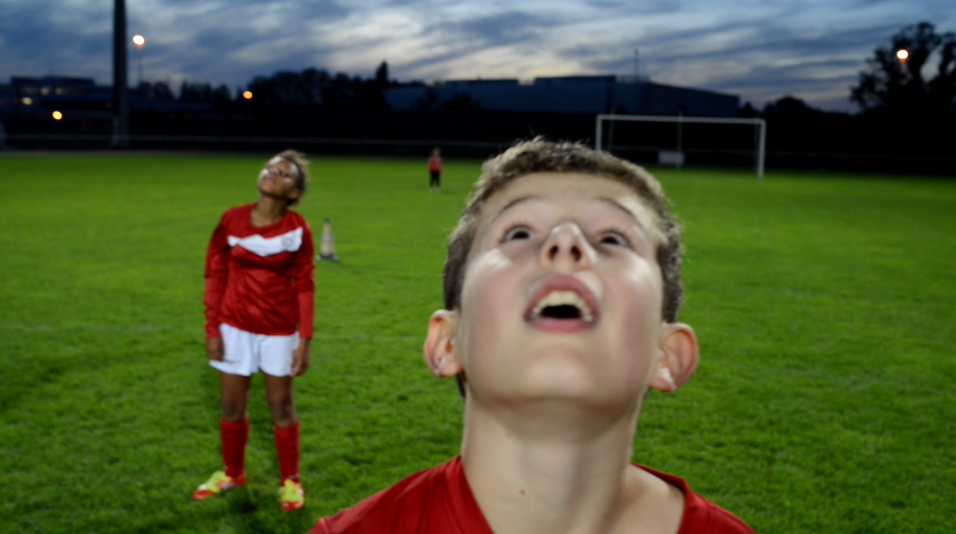
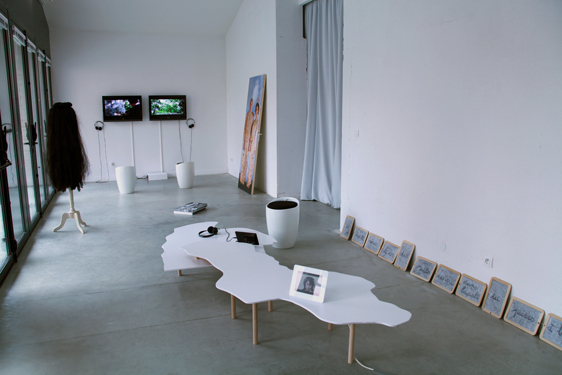
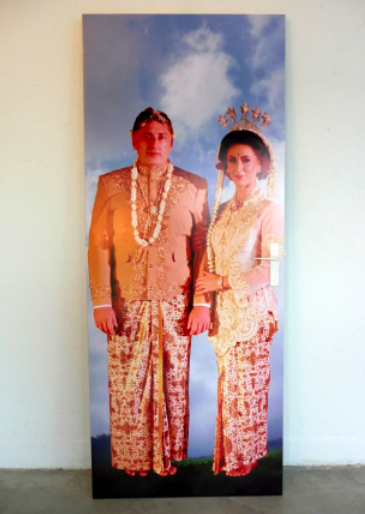
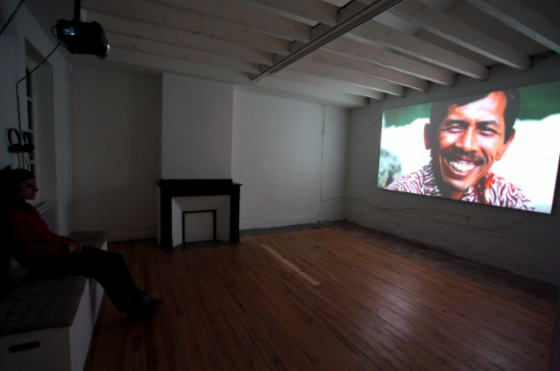
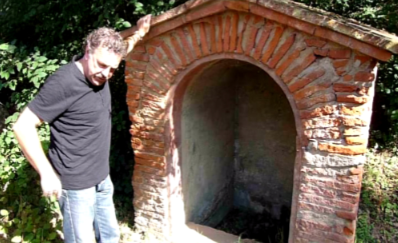
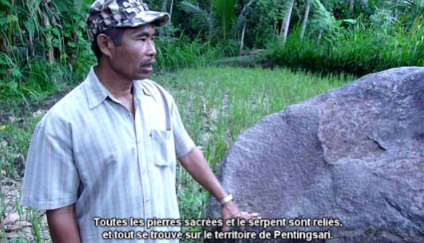

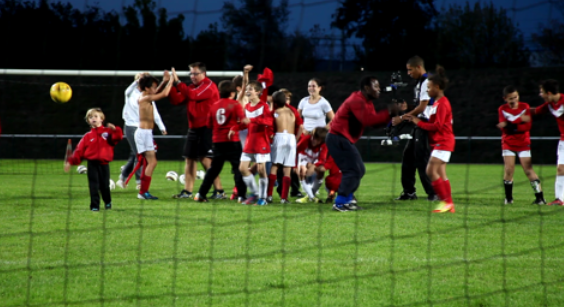

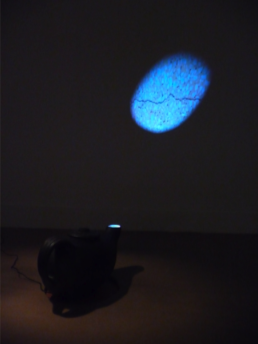
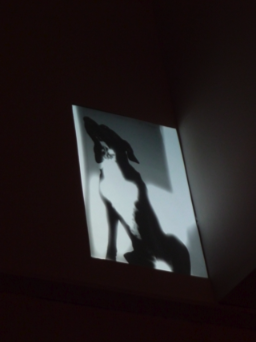
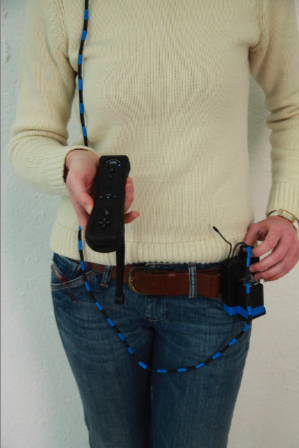
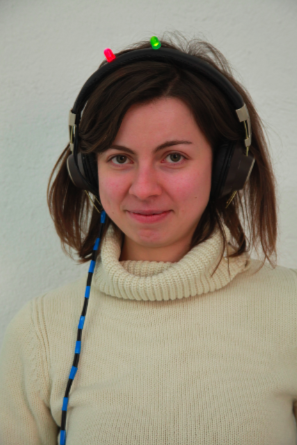
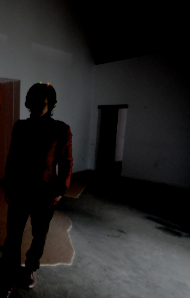
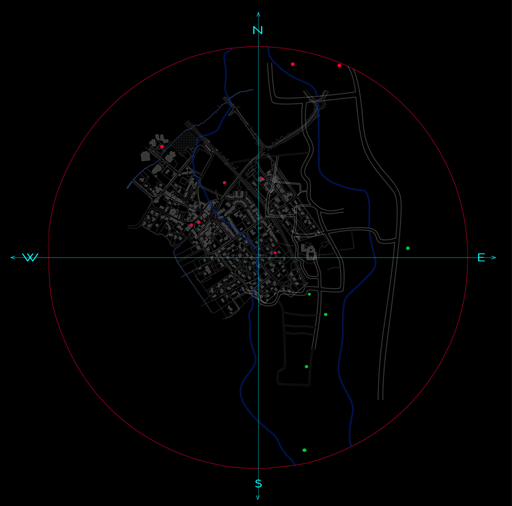
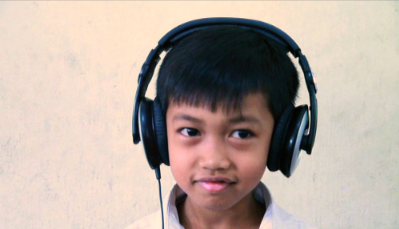
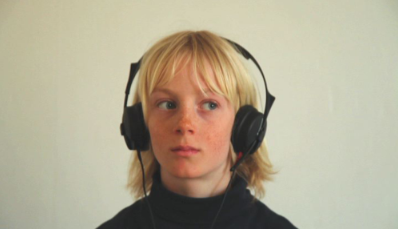
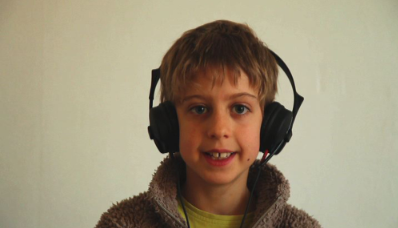
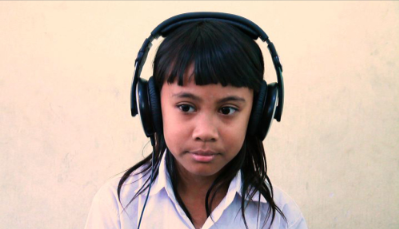
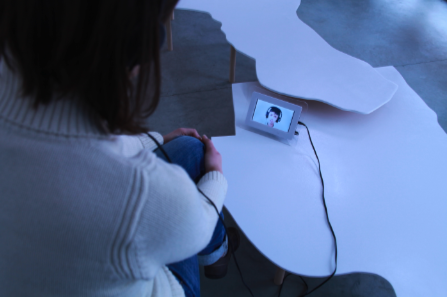
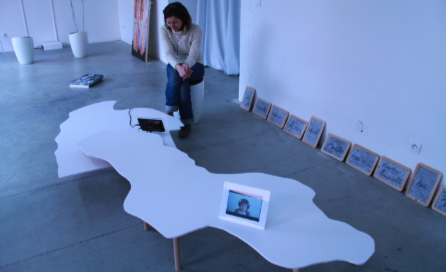
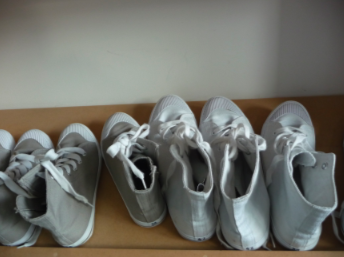
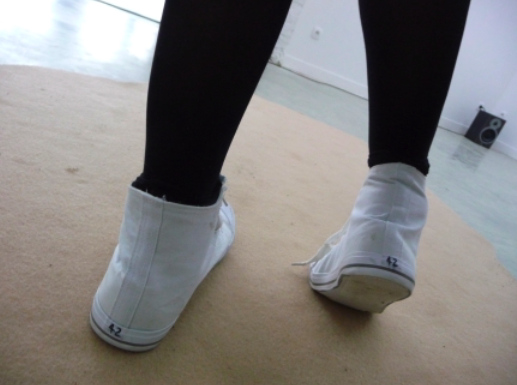
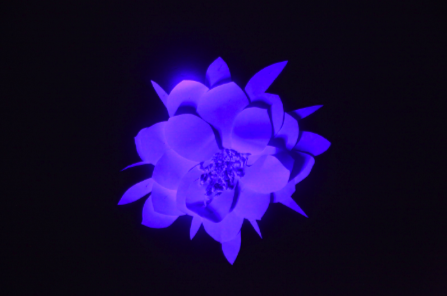
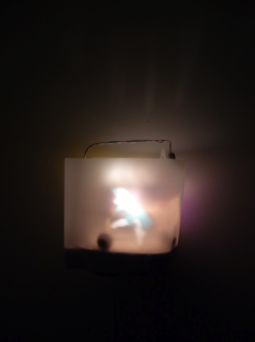
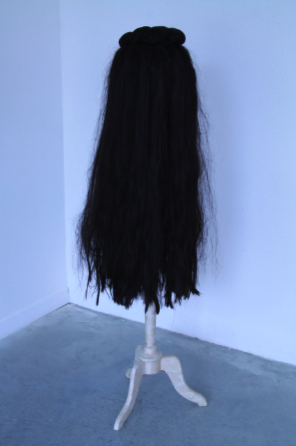
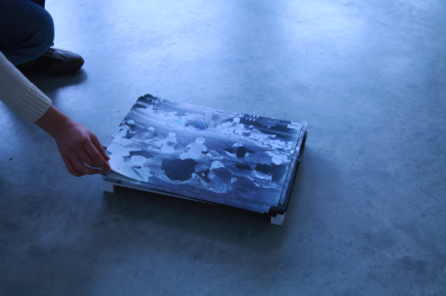
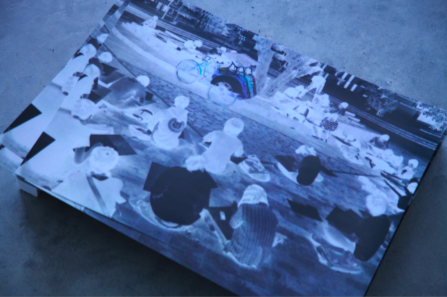
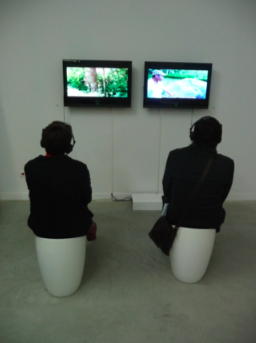
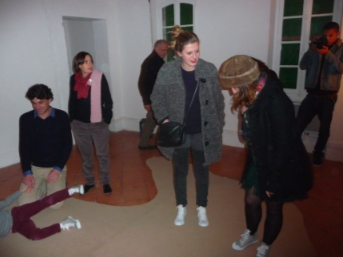
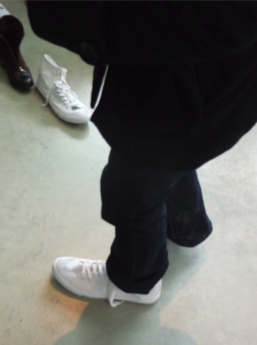
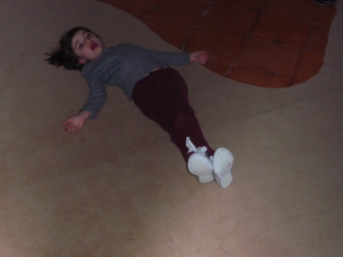
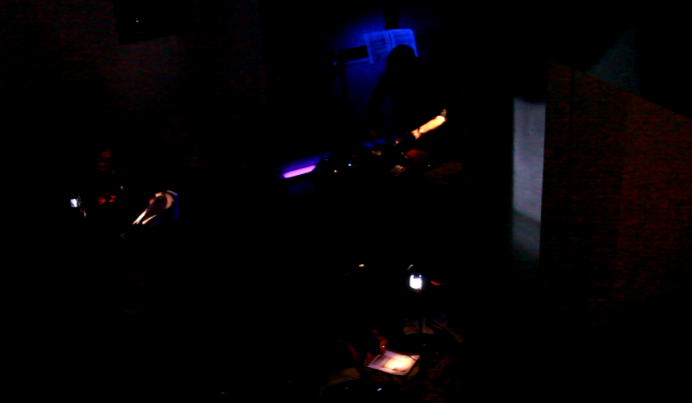

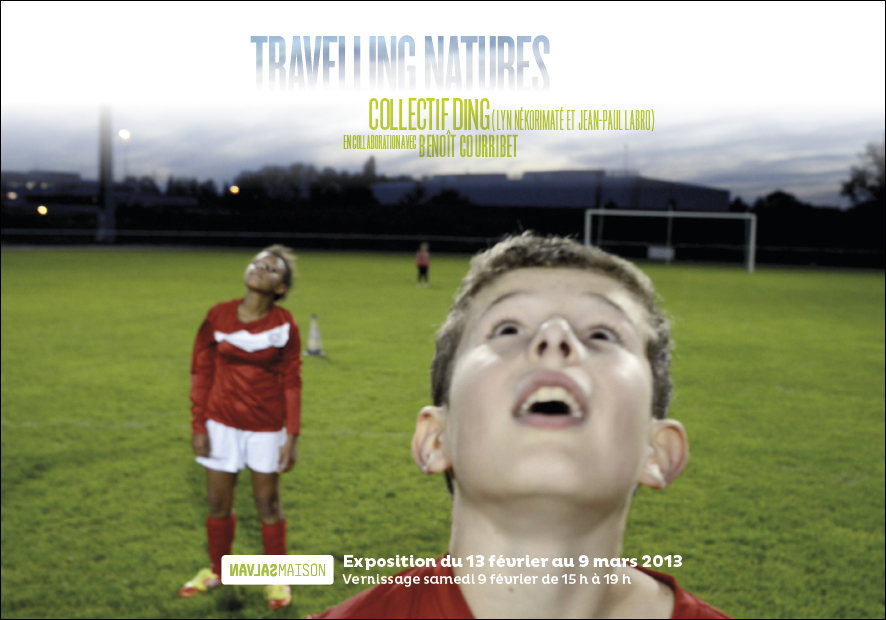
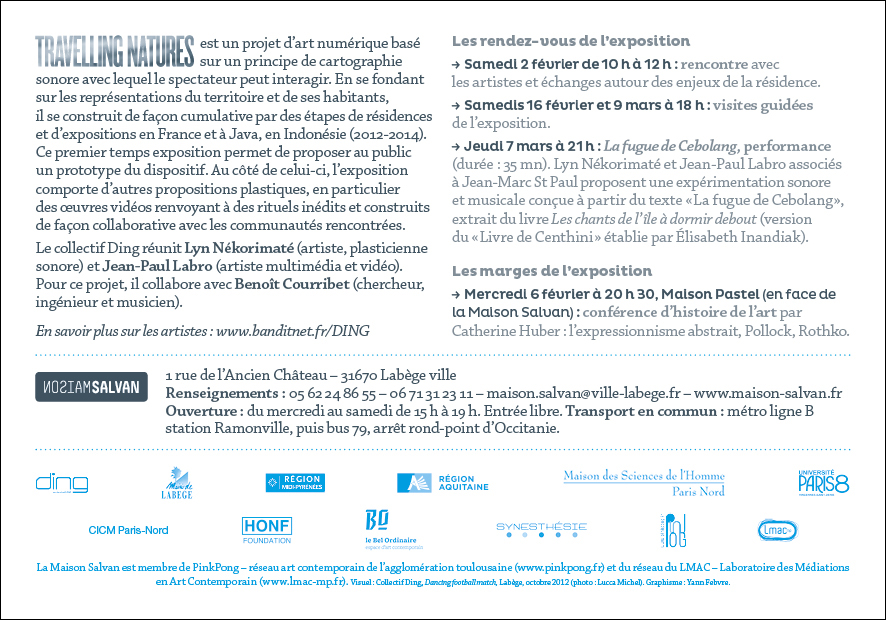
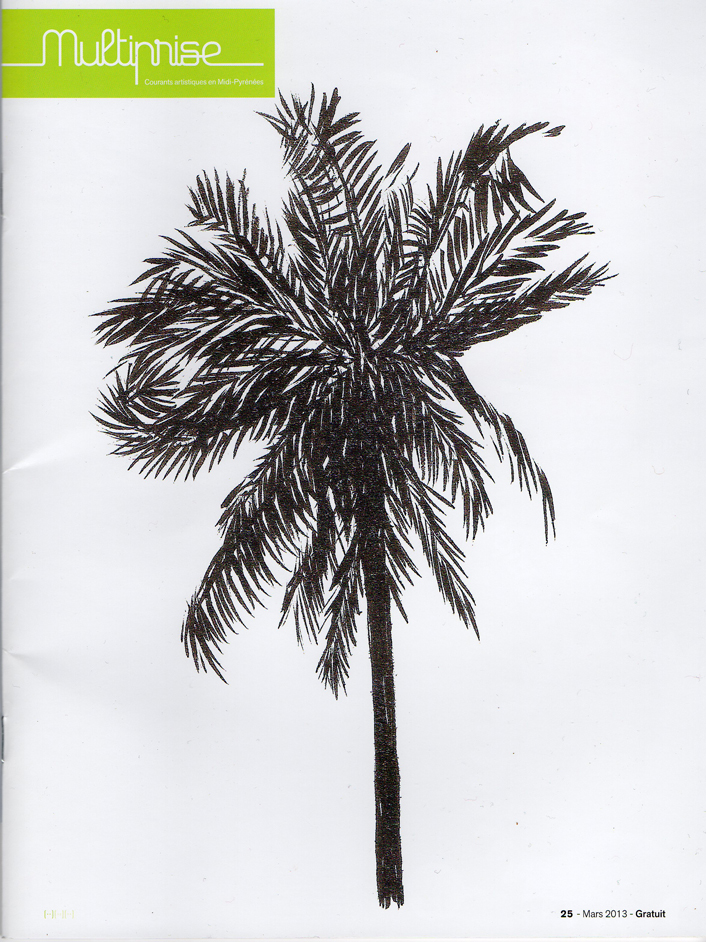



STONES ARE SPEAKING, WATER IS TELLING
Installation vidéo - Deux moniteurs
Durée des vidéos : 32'34"
De genre documentaire, les deux vidéo mettent en parallèle des mythologies de lieux. Sous l'oeil mobile de notre caméra, des histoires sont racontées en marchant, par Jean-Paul Lorenzon à Labège et par Mas Marianto à Pentingsari. Les deux récits se rattachent à un patrimoine du sacré que les habitants conservent dans leur mémoire et leurs pratiques, en dehors des temples et des églises. À Labège, il renvoie à la fontaine de Saint Sernin, qui fût martyrisé par un taureau à Toulouse au III ème siècle. À Pentingsari, il s'attache à des sites où se sont enfoncés il y a plusieurs centaines d'années d'énormes blocs de pierres projetées par le volcan Merapi.
PARTNERS
CONTACT
EXHIBITIONS / EVENTS
WORKS
PROJECTS
NEWS
EXHIBITION
13 February to 9 March 2013
Maison Salvan
Labège
TRAVELLING NATURES #1
STONES ARE SPEAKING, WATER IS TELLING
Video installation - Two monitors
Duration of videos: 32 ' 34 "
From documentary gender, both video put in parallel mythologies of places. Under the mobile eye of our camera, stories are told by walking, by Jean-Paul Lorenzon in Labège and by Mas Marianto in Pentingsari. Both narratives are connected with a heritage of the sacred which the inhabitants keep and preserve in their memory and their practices, except temples and churches. In Labège, it sends back to saint Sernin's fountain, who is tortured by a bull in Toulouse in the III century. In Pentingsari, it becomes attached to sites where sank, several hundreds of years ago, enormous blocks of stones thrown from the volcano Merapi there.
EDITO
L'exposition Travelling Natures à la Maison Salvan marque le premier jalon d'une démarche envisagée comme migratoire, à ce titre elle revêt un caractère prototypique. Le projet est amené à se développer à travers d'ultérieures étapes de résidences et d'expositions en France et en Indonésie, jusqu'en 2015. A ce jour, le projet s'est principalement construit auprès d'individus des "communautés" de Labège ainsi que de Pentingsari, village de l'île de Java. Il se fonde tout autant sur des protocoles renvoyant à l'observation que sur des propositions de dispositifs participatifs.
Travelling Natures est ainsi un projet qui se construit au contact de territoires et de communautés d'habitants. Une série de questions pourraient constituer le point de départ de la recherche artistique du collectif DING. Comment les individus vivent-ils le territoire? Comment le monde de la nuit, celui de l'invisible, des esprits, interfèrent avec le quotidien? Comment les communautés mobilisent et/ou inventent des rites pour comprendre le monde, pour collectivement y prendre part? Quels sont les liens objectifs et subjectifs entre les hommes et les cadres de vie? Nécessairement, - Lyn et Jean-Paul ne sont pas ethnologues - le regard porté est tout autant fantasmagorique que focalisé sur des dimensions tangibles, explicites.
L'exposition à la Maison Salvan est ce regard. A travers des pièces renvoyant à des pratiques artistiques diversifiées - art vidéo, installations, art numérique... - les ratistes proposent une atmosphère flottante et rêveuse où se tisse différentes dimensions de l'être au monde. Le public peut alors aborder des territoires indonésiens et français par le prisme de la poésie, selon une forme de méditation sur l'homme - de l'exposition transparaît un profond respect des artistes pour les personnes rencontrées - à travers une forme d'utopie dans laquelle le diurne et le nocturne, le songe et l'inscription dans le réel, se rencontrent pour former un parfait et très naturel syncrétisme.
Dans le film "Level 5", Chris Marker dit qu'il est parfois préférable de faire émerger une image à partir du vide plutôt que depuis une idée. Le réalisateur est très proche de la culture japonaise, le vide est ainsi à entendre dans son acception orientale : comme un vide du bruit de la vie mais comme un plein de pensées primitives et premières permettant de réunir le corps à la nature (dans l'espace) et l'esprit au cosmos (dans le temps). Ce vide est un état physique, particulier, de pensée et de connexion à tout ce qui environne ; au fond, Travelling Natures parle beaucoup de cela aussi. Effectivement, l'exposition propose peut-être au public une expérience dans laquelle il faut perdre ses repères pour aborder la vie dans une globalité déraisonnable... et être attentif à être, à voir. Il ne serait alors plus question de Labège, de France, de Pentingsari, d'Indonésie. Dans un territoire rêvé, culturellement hybride, inonder le monde du jour par celui de la nuit et rpoposer au public d'évoluer dedans, voilà peut-être la nature du travelling proposé par Lyn et Jean-Paul.
Paul de Sorbier, Directeur de la Maison Salvan, Labège
DING collective (Lyn Nekorimate & Jean-Paul Labro) in collaboration with Benoit Courribet
Dans le cadre de cette exposition, la Maison Salvan est partenaire du festival Made in Asia, Toulouse / With this exhibition, the art center Maison Salvan is a partner of the Asian Festival in Toulouse.
Ici
se distille, avec le don des nuits,
une voix
dans laquelle tu puises à boire.
Paul Celan, "Grille de paroles"
EDITORIAL
The Travelling Natures exhibition at the Maison Salvan art center, marks the first milestone of an approach envisaged as migratory, as such it takes on a prototypical character. The project is brought to develop through of later stages of residences and exhibitions in France and in Indonesia, until 2015. To date, the project mainly built itself with induvidus of the "communities" of Labège as well as Pentingsari, village of the Java Island. It bases itself just as much on protocols sending back to the observation that on proposals of participative devices.
Travelling Natures is so a project which builds itself in the contact of territories and inhabitants' communities. A series of questions could establish the starting point of the artistic research for the collective DING. How do the individuals live the territory? How the night world, the one of the invisible, the spirits, interfere with the everyday life? How communities mobilize and/or invent rites to understand and include the world, to take part in it collectively? What are the objective and subjective links between people and the living environments? Inevitably, - Lyn and Jean-Paul are not ethnologists - the worn look is just as much phantasmagorical than focused on tangible, explicit dimensions.
The exhibition at the Maison Salvan is this look. Through pieces sending back to diversified artistic practices - video art, installations, digital art - the artists propose a floating and dreamy atmosphere where weaves various dimensions of the being to the world. The public can then approach Indonesian and French territories by the prism of the poetry, according to a shape of meditation on the human being - the exhibition shows through a profound respect for the artists for the met persons - through a shape of utopia in which the diurnal and the night -, the dream and the inscription in the reality, meet to form a perfect and very natural syncretism.
In the movie " Level 5 ", Chris Marker says that it is sometimes preferable to bring to the foreground an image from the space rather than since an idea. The director is very close to the Japanese culture, the space so is to be understood in its oriental meaning of a word : as a space of the noise of the life but as a height of primitive and first thoughts allowing to gather the body in the nature (in the space) and the spirit in the cosmos (in the time). This space is a physical, particular state, of thought and connection to all which surrounds ; in fact, Travelling Natures' project speaks many of it too. Effectively, the exhibition proposes maybe to the public an experience in which it is necessary to lose its marks to approach the life on an unreasonable global nature and be attentive to be, to see. It would not be then any more question of Labège, France, Pentingsari, Indonesia. In a dreamed territory, culturally hybrid, flood the day world by that of the night and invite the public to evolve inside, here is maybe the nature of the travelling proposed by Lyn and Jean-Paul.
Paul de Sorbier, Director of the Maison Salvan, Labège, France.
Here
distils, with the gift of the nights,
a voice
in which you draw to drink.
Paul Celan, " Railing of words "
DANCING FOOTBALL MATCH
Projection vidéo
Durée 14'28"
Le "Dancing football match" est le film d'une performance collective et collaborative éponyme qui s'est déroulée le 24 octobre 2012 sur un stade de football de Labège. Ici, non sans humour et actes de détournement, nous avons demandé aux footballeurs de se prêter au jeu de la chorégraphie et aux danseuses de déplacer leurs pratiques sur un terrain de football, tandis que les habitants de Labège étaient invités à figurer dans les tribunes du stade. Dans ce projet, la réalisation du film fonde son enjeu artistique sur la mise en œuvre du tournage, ici traitée comme un acte cérémoniel, où la communauté est en capacité de s'unir et d'activer ce qui, selon toute apparence, semble contradictoire.
(Merci pour leur participation au "Labège Football club" et à l'association "À corps et à danse")
DANCING FOOTBALL MATCH
Video projection
Duration 14'28"
The " Dancing football match " is the movie of a collective performance and eponym collaborative which took place on October 24th, 2012 on a stadium of football of Labège. Here, not without humor and acts of misappropriation, we asked to the football players to enter into the spirit of the game of the choreography and to the dancers to move their practices on a soccer field, whereas the inhabitants of Labège were invited to appear in the forums of the green stage. In this project, the realization of the movie its artistic stake on the implementation of the shooting, here treated as a ceremonial act, where the community is in capacity to unite and to activate what, apparently, seems contradictory.
( Thank you for their participation : "Labège Football club" and the association " À corps et à danse ")
LES ERRANCES DU MONDE À L'ENVERS
Projection vidéo
Durée : 44'
Synopsis :
Suite à des guerres sanglantes entre royaumes, les trois enfants du souverain de Giri, Jayengresmi, Rancangkapti et Jayengsari s'enfuient et errent sur l'île de Java. Cette errance les initie aux arts de la vie et de la déraison au travers de multiples rencontres qui les amèneront à découvrir les sciences et les cultures, les rites et les mythes de leur île.
"Les errances du monde à l'envers" est un film réalisé à partir du texte "Le livre de Centhini". C'est un gigantesque chant composé au XIX ème siècle (1809) qui renvoit à la mythologie de l'île de Java. L'auteur contemporain Elisabeth D. Inandiak a composé un travail de relecture en langue française du texte original*. Il s'agit à la fois d'une œuvre de synthèse mais aussi de création puisqu'elle y a insufflé son propre regard, à la fois épique et joyeux. La rencontre avec Elisabeth D. Inandiak a permis l'étude entre les lignes de ce monstre littéraire. Le texte, à travers le prisme de personnages errants, en quête d'eux-mêmes, permet l'agrégation d'éléments liés à la mémoire et aux savoirs traditionnels de Java.
Cet ouvrage fabuleux et initiatique est notre compagnon de route depuis notre premier voyage à Java, il est aussi le pont sacré pour rencontrer les javanais. Partager ce texte, c'est le lire, le chanter, faire un film... Aussi bien en France qu'en Indonésie, chacune des phases de résidence du projet Travelling Natures a été l'occasion de tourner de nouvelles séquences du film que nous avons voulu aussi nomade que les personnage qu'il met en scène. Imaginé en trois épisodes, c'est la première partie qui est montrée à la Maison Salvan.
* "Les chants de l'île à dormir debout", Le livre de Centhini par Elisabeth D. Inandiak est paru en édition de poche Point/Sagesses, au Seuil, ainsi qu'aux éditions Le relié.
THE WANDERINGS OF THE INVERSE WORLD
Vidéo projection
Duration : 44'
Synopsis :
Further to bloody wars between kingdoms, three children of the sovereign of Giri, Jayengresmi, Rancangkapti and Jayengsari run away and roam on the Java Island. This wandering introduces them to the arts of the life and the nonsense through multiple meetings which will bring them to discover the sciences and the cultures, the rites and the myths of their island.
" The wanderings of the inverse world " is a movie realized from the text "Centhini book". It is a gigantic song consisted in XIX ème century ( 1809 ) that tells the mythology of the Java Island. The contemporary author Elisabeth D. Inandiak composed a work of review in French language of the original text*. It is at the same time about a work of synthesis but also about a creation because she breathed it her own, at the same time epic and joyful view.The meeting with Elisabeth D. Inandiak allowed the study between the lines of this literary monster. The text, through the prism of wandering characters, in search of themselves, allows the aggregation of elements connected to the memory and to the traditional knowledges of Java.
This fabulous and initiatory work is our fellow traveller since our first journey on Java, it is also the bridge crowned to meet the Javanese. Sharing this text, it is reading it, singing it, making a movie... As well in France as in Indonesia, each of the phases of residence of the project Travelling Natures was the occasion to shoot new sequences of the movie which we wanted so nomadic as character whom its stages. Imagined in three episodes, it is the first part which is shown at the Maison Salvan art center.
* " Forty nights and one of rain", The Centhini book by Elisabeth D. Inandiak
PORTE DES MARIÉS
Porte et tirage numérique
À l'instar de Tchekov Minosa et Brigitte de Saint-Preux*, nous avons décidé de nous marier plusieurs fois selon des rites issus de cultures différentes. Sans suivre une ligne directrice géographique prédéfinie, nous nous sommes saisis de l'occasion de notre voyage en Indonésie pour consommer notre deuxième mariage. Nous nous sommes unis selon un rituel Javanais à Yogyakarta le 28 septembre 2012. La photographie de cérémonie marouflée sur une porte bon marché relativise la finalité de notre projet, d'attendre une part de sacré qui nous est étranger, de vivre une histoire d'amour rocambolesque.
Nous remercions tout particulièrement Irene Agrivine et ses parents, ainsi que tous les invités.
* Entre 1966 et 1969 Tchekov Minosa et Brigitte de Saint-Preux ont arpenté le route de l'Orien de la Turquie à l'Inde et se sont mariés dix fois selon des rites Turcs, Kurdes, Kouchi, Turkmènes... Leurs aventures a fait l'objet d'une édition parue chez Robert Laffont.
DOOR OF THE BRIDEGROOMS
Door and digital edition.
Following the example of Tchekov Minosa and Brigitte de Saint-Preux *, we decided to get married several times according to rites stemming from different cultures. Without following a predefined geographical guideline, we seized the opportunity of our journey in Indonesia to consume our second marriage. We united according to a Javanese rite in Yogyakarta on September 28th, 2012. The photography of ceremony on a door puts in perspective the purpose of our project, to wait for a part of crowned which is foreign to us, to live a weird love story.
We thank quite particularly Irene Agrivine and her parents, as well as all the guests.
* Between 1966 and 1969 Tchekov Minosa and Brigitte de Saint-Preux measured road of Orien of Turkey in India and got married ten times according to Turkish rites, Kurds, Kouchi, Turkmens... Their adventures was the object of a publishing appeared at Robert Laffont Editions.
LE GÉNIE DU LIEU
Céramique (réalisée au château de Ratilly) / Vidéo projecteur Pixo
Nous avons demandé à Paul de Sorbier, le directeur de la Maison Salvan, ce qu'était pour lui le génie du lieu. C'est l'ombre nous a-t-il répondu. Elle se loge dans les interstices et les fissures de la maison pour nous rappeler sa mémoire.
THE GENIUS OF THE PLACE
Ceramic (realized in the castle of Ratilly) / Video-projector Pixo
We asked to Paul de Sorbier, the director of the Maison (House) Salvan, for the fact that was for him the genius of the place. It is the shadow he answered us. It finds accommodation in chinks and cracks of the house to remind us her(its) memory.
ECHOERRANCE
Dispositif électroacoustique, PC, Webcam, Sono, casque, Wii.
"Echoerrance" est une installation sonore proposant une déambulation dans des espaces sonores interactifs. Au cours de nos différentes résidences, nous avons effectué un travail de captation sonore, puis de catégorisation de ces enregistrements. Ont été dressées différentes cartographies** que nous cherchons à rendre sensibles dans l'espace d'exposition.
Sur la base de ces sons, Benoît Courribet* propose une composition électroacoustique interactive, diffusée dans les enceintes, ainsi qu'un environnement sonore immersif au casque , grâce à un système de captation de mouvement et de synthèse sonore binaural : les différents sons s'organisent en espaces sonores mouvants, réagissant aux mouvements des spectateurs munis d'un casque et/ou d'une télécommande.
S'il s'agit en partie d'avoir accès à un recueil sonore de nos voyages, et, par le jeu de composition en direct, créer une forme plastique dont le statut soit proche de la sculpture. Comme une sculpture sonore, composite et mouvante, "Echoerrance" se perçoit dans le temps, l'espace et la durée d'une visite. C'est aussi le spectateur qui la modèle, avec ses lignes de fuite, ses mouvements, ses stations.
* Benoit Courribet est chercheur au CICM / Université Paris 8
** La cartographie est un des premiers dispositifs jetant les bases de la mondialisation, à l'œuvre depuis que le phénomène de colonisation existe. Aujourd'hui les technologies satellitaires permettent une rationalisation graphique quasi absolue des territoires. La géolocalisation planétaire de nos déplacements pour peu qu'on en use, modifie nos comportements et atteint dans son acception la notion même du nomadisme. En proposant une expérience kinesthésique basée sur l'écoute, le dispositif "Echoerrance" prend le parti de dématérialiser les repères visuels de la cartographie.
Conception : Collectif DING & Benoit Courribet
Réalisation du dispositif multimédia : Benoit Courribet
Production du prototype : Maison Salvan / Mairie de Labège
Ce projet a reçu le soutien du Conseil Régional d'Aquitaine.
Il est réalisé en partenariat avec Synesthésie et le CICM / Universté de Paris 8 de Saint-Denis
ECHOERRANCE (Wanderingechoe)
Electroacoustics devices, PC, Webcam, Sound system, headphones, Wii.
"Echoerrance" is a sound installation proposing a wandering in interactive sound spaces. During our various residences, we made a work of sound captation, then categorization of these recordings. Various mappings ** were drawn up to create a sensitive area in the space of exhibition.
On the basis of these sounds, Benoît Courribet* proposes an interactive electroacoustic composition, spread in surrounding speakers, as well as a sound dumping environment in the headphones, with a system of captation of movement and sound synthesis binaural : the various sounds get organized in unstable sound spaces, reacting to the movements of the spectators provided with a headphones and/or with a remote control.
If it is partially a question of having access to a sound collection of our journeys, we want, by the game of live composition, to create a shape blows up the status of which is close to the sculpture. As a sound, composite and unstable sculpture, "Echoerrance" lives in the time, the space and the duration of a visit. It is also the spectator who models it, with his base lines, the movements, the stations.
* Benoit Courribet is a researcher in the CICM / Paris 8 university
** The mapping is one of first devices laying the foundations for the globalization, in the work since the phenomenon of colonization exists. Today the satellite technologies allow a graphic rationalization almost absolved from territories. The global geo-localization of our movements if we use it, modifies our behavior and affects in its meaning the notion of the nomadism. By proposing a kinaesthetic experience based on the listening, the device " Echoerrance " decides to dematerialize the visual marks of the mapping.
Conception : collective DING and Benoit Courribet
Realization of the multimedia device: Benoit Courribet
Production of the prototype: Maison Salvan / City of Labège
This project received the support of the Regional council of Aquitaine.
It is realized in partnership with Synesthesie and the CICM / Universty of Paris 8 of Saint-Denis
KATA BERANTAI (Le mot de la chance en Indonésien)
Installation vidéo
Durée :de la séquence vidéo : 5'48"
Durée de la séquence photos : 3'20"
Bois / Deux cadres photos numériques
L'installation est composée de cartes-plateaux d'un fragment de Labège et de Pentingsari sur lesquels sont disposés deux petits écrans. Les plateaux sont modulaires et pourront être recombinés avec d'autres en fonction de nouveaux territoires de résidence.
Sur les écrans, nous diffusons deux séquences d'images réalisées avec les enfants des écoles de Labège et de Pentingsari. Nous leur avons proposé d'organiser entre la France et l'Indonésie, un jeu de "téléphone arabe" (Kata Berantai). Dans la première séquence, les enfants indonésiens et français tentent de répéter les courtes phrases que leurs homologues du bout du monde ont laissé pour eux sur un enregistreur numérique. Nous constatons l'émergence d'une troisième langue qui sera, nous l'espérons, entendue par les auditeurs curieux de chants d'oiseaux et de musique. La deuxième séquence est composée d'une succession de portraits photographiques des enfants réalisés avant la prise de parole. C'est le temps suspendu de l'écoute, la séquence fait apparaître des expressions inquiètes et amusées qui témoignent de leur état intérieur.
KATA BERANTAI (The word of the luck in Indonesian)
Video installation
Duration of the video sequence: 5 ' 48 "
Duration of the photos' sequence: 3 ' 20 "
Wood / Two digital photo frames
The installation consists of maps-trays of a fragment from Labège and from Pentingsari on which are arranged two small screens. Trays are modular and can be recombined with others, according to new territories of residence.
On screens, we spread two sequences of images realized with the children of the schools of Labège and Pentingsari. We suggested them organizing between France and Indonesia, a game of "bush telegraph" (Kata Berantai). In the first sequence, the Indonesian and French children try to repeat the short sentences that their counterparts of the end of the world left for them on a digital recorder. We notice the emergence of the third language which will be, we hope for it, heard and understood by the auditors curious about songs of birds and about music. The second sequence consists of a succession of photographic portraits of the children realized before the speaking. It is the time suspended by the listening, the sequence creates worried and amused expressions which testify of their internal state.
ADHESIVE FLOOR
Bois, moquette, baskets, Velcro
À l'inverse de l'artiste Panamarenko qui marchait au plafond avec des chaussures aimantées, nous proposons une expérience d'adhésion sur le sol de la Maison Salvan, à l'aide de baskets équipées de Velcro.
"Adhesive floor" pourrait être le nom d'un club échangiste. Il est l'image cartographique de Labège et de Pentingsari que nous avons décliné plusieurs fois dans l'exposition. Cette image est matérialisée par un plancher recouvert d'une moquette qui colle à la semelle. C'est une manière de revenir au sens que l'on donne à nos actes les plus simples, comme de marcher, d'arpenter, de voyager...
ADHESIVE FLOOR
Wood, carpet, sneakers, Velcro
Contrary to the artist Panamarenko who walked to the ceiling with magnetized shoes, we propose an experience of membership on the ground of the Maison Salvan, by means of shoes equipped with Velcro.
" Adhesive floor " could be the name of a partner-swapping club. It is the cartographic image of Labège and Pentingsari which we declined several times in the exhibition. This image is realized by a floor covered with a carpet which sticks on the sole. It is a way of returning to the sense which we give in our simplest acts, as to walk, to measure, to travel...
WIJAYA KUSUMA
Papier, colle, épingles, bouchons, néon de lumière noire.
L'œuvre est un fac-similé de papier inspiré d'une photographie de la fleur Wijaya Kusuma.
Présente dans le livre de Centhini comme une fleur mythique, la Wijaya pousse en Indonésie. Comme la "Belle de nuit", elle s'ouvre au crépuscule et se fane à l'aurore. On l'appelle aussi la fleur de l'amour.
WIJAYA KUSUMA
Paper, glue, pins, corks, neon of black light.
The work is a facsimile of paper inspired by a photography of the flower Wijaya Kusuma.
Present in the book of Centhini as a mythical flower, Wijaya grows in Indonesia.
As " Beautiful of night ", it opens to the twilight and fades in the dawn. We also call it the flower of the love.
LANTERNE TUE MOUCHE
Lanterne magique détournée, ventilateur, dessin, double face.
À l'origine du cinématographe, il y a la lanterne magique et le théâtre d'ombres qui sont tous les deux des dispositifs de projection lumineuse. Vecteur de sacré dans l'espace profane, le Wayang Kulit, théâtre d'ombres indonésien, transporte sur sa toile les mythologies hindouistes et javanaises. Notre lanterne magique qui a deux fonctions, insecticide et récréative, projette une scène de mythologies détournées. Nous avons demandé à un ami dessinateur de caricaturer l'Aigle Garuda (fondateur de l'Indonésie) poursuivant un homme d'église et le Taureau sacrificateur de Saint Sernin poursuivant un Imam. Attention, la lanterne est en partie recouverte d'un adhésif très puissant qui colle aux doigts autant qu'aux mouches.
LANTERN KILLED BLOW
Hijacked magic lantern, ventilator, drawing, double face.
At the origin of the cinematograph, there is the magic lantern and the shadow theater which are both devices of light projection. Vector of sacred in the profane space, the Wayang Kulit, the Indonesian shadow theater, transport on its canevas the Hindu and Javanese mythologies. Our magic lantern which has two functions, insecticidal and entertaining, plans a scene of hijacked mythologies. We asked to a friend draftsman to caricature the Eagle Garuda (founder of Indonesia) pursuing a man of church and the Taurus sacrificer of saint Sernin pursuing an Imam. Attention, the lantern is partially covered with a very powerful adhesive which sticks on fingers as much as on flies.
PAQUITA
Projection vidéo
Paquita, la chienne errante. Nous l'avons croisée plusieurs fois à Labège, parfois elle ne refusait pas les caresses, toujours elle traçait son chemin. Elle nous a amené jusqu'à ses maîtres, qui ont bien voulu l'accompagner pour une séance de tournage vidéo. Paquita, érigée dans l'exposition comme une icône céleste, trône dans nos cœurs et sur nos âmes.
Merci à Paquita, Franck Zurano et sa famille.
PAQUITA
Video projection
Paquita, the wandering dog. We crossed her several times in Labège, sometimes she did not refuse caresses, always she drew her way. She brought to us up to her masters, who were kind enough to accompany her for a session of video shooting. Paquita, set up in the exhibition as a celestial icon, a throne in our hearts and on our souls.
Thanks to Paquita, Franck Zurano and his family.
POSTER BECAK, à emporter...
Le poster est une image issue d'un fascicule de l'Institute of Arts de Yogyakarta. Il présente des étudiants en train de dessiner un becak. Le becak est un vélo équipé d'une nacelle avant pour conduire à peu de frais les autochtones et les touristes dans les centres-villes. Nous avons idéalisé plusieurs projets avec le becak, nous les gardons pour l'avenir. L'image que nous avons transformée donne à voir son négatif, comme l'envers mental d'une projection, d'un désir.
POST BECAK, to take...
The poster is an image stemming from a part of Institute of Arts of Yogyakarta. It presents students drawing a becak. The becak is a bike equipped with a nacelle before to drive at little cost the natives and the tourists in city centers. We idealized several projects with the becak, we keep them for the future. The image which we transformed gives to see its negative, as a mental inverse of a projection, a desire.
TRENGGANAWULAN
Perruque en cheveux synthétique
Un des costumes du film "Les errances du monde à l'envers"
TRENGGANAWULAN
Synthetic hair
One of the costumes of the movie " The wanderings of the inverse world "
Dans le cadre du projet Travelling Natures (2012-2015), le collectif DING et la Maison Salvan sont partenaires du Bel Ordinaire (Billère-Pau), de Synesthésie (Saint-Denis), de la Maison des Sciences de l'Homme et du Centre de Recherche Informatique et Création Musicale (Saint-Denis) ainsi que le HONFablab de Yogyakarta.
Au delà du soutien de la ville de Labège et de la Maison Salvan, Travelling Natures est soutenu par le Conseil Régional d'Aquitaine (Aide à la mobilité), à la DRAC Aquitaine (Aide à l'équipement), le Bel Ordinaire de Billère-Pau, l'Institut Français de Yogyakarta, HONF Foundation de Yogyakarta.
Régie technique : Guillaume Landron, Kevin Rouillard, Lise Mazin.
Within the framework of the project Travelling Natures ( 2012-2015 ), the collective DING and the Maison Salvan are partner of the Bel Ordinaire ( Billère-Pau), Synesthésie (Saint-Denis), the House of the Human Sciences and the Computing Research and Musical Creation Center (Saint-Denis) and the HONFablab from Yogyakarta.
Beyond the support of the city of Labège and the Maison Salvan, Travelling Natures is supported by the Regional Council of Aquitaine (Help to the mobility), the DRAC Aquitaine (Help to the equipment), Bel Ordinary of Billère-Pau, the French Institute of Yogyakarta, HONF Foundation from Yogyakarta.
Control room: Guillaume Landron, Kevin Rouillard, Lise Mazin.
La Maison Salvan est membre de Pink-pong - réseau d'art contemporain de l'agglomération de Toulouse et le réseau LMAC - Laboratoire des Médiations en Art Contemporain.
La Maison Salvan est soutenue par la Région Midi-Pyrénées
The Maison (House) Salvan is a member of Pink-pong - network of contemporary art of the surrounds of Toulouse and the LMAC network - Laboratory of the Mediations in Contemporary Art.
The Maison Salvan is supported by the Region Midi-Pyrénées.
LA FUGUE DE CEBOLANG
Concert de cloture d'exposition
THE FUGUE OF CEBOLANG
Concert of cloture of exhibition
Retour en haut de page / Return to the top of the page
^
CARTON D'INVITATION / INVITATION FLYER
Travelling Natures / Le réel entre pesanteur et apesanteurs
Texte de Gunther Ludwig / parution dans la revue Multiprise, mars 2013, Toulouse
Ce film ne peut être vu que dans un cadre privé et en présence des artistes.
This movie can be seen only in a private frame and in the presence of the artists.
Réalisé avec le soutien du HONFablab (Yogyakarta)
Réalisé avec le soutien du HONFablab (Yogyakarta)
Realized with support HONFablab (Yogyakarta)
Realized with support HONFablab (Yogyakarta)
Realized with support HONFablab (Yogyakarta)
Réalisé avec le soutien du HONFablab (Yogyakarta)
ARTICLES







































